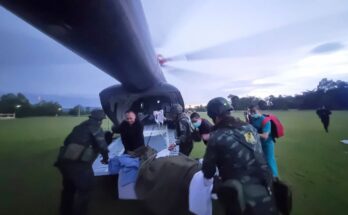
Tensions worsened in May when a Cambodian soldier was killed during a brief clash between Thai and Cambodian troops in a contested border area of the Emerald Triangle, where Cambodia, Thailand, and Laos meet.
Thai and Cambodian forces said they were acting in self-defense and blamed the other for the skirmish.
Although military leaders from Thailand and Cambodia said they wished to de-escalate, both sides have since engaged in saber-rattling and reinforced troops along the border.
Thailand took control of border checkpoints, imposed restrictions on crossings and threatened to cut electricity and internet to Cambodia’s border towns. Cambodia, in return, stopped imports of Thai fruit and vegetables and banned Thai movies and TV dramas.
Recent landmine explosions prompted both countries to downgrade relations with each other and recall diplomatic staff.
The first soldier lost his leg in a landmine explosion on July 16. The second incident occurred Wednesday, when a blast injured five Thai soldiers, with one losing his leg. Thursday’s violence marked a significant escalation.
The conflict has had huge political ramifications in Thailand.
Thailand’s Prime Minister Paetongtarn Shinawatra was suspended from duties on July 1 after the leak of a phone call she had with Cambodia’s powerful former leader Hun Sen in June, in which she appeared to criticize her own army’s actions in the dispute.
Shinawatra hails from a powerful dynasty and became Thailand’s youngest prime minister last year, at just 38. She could face full dismissal over the call, in which she appeared to signal there was discord between her government and the powerful Thai military.
Few international tourists visit the area where Thai and Cambodian forces clashed
The area where Thai and Cambodian forces clashed today, near the ancient Ta Muen Thom Temple, is not considered a popular destination for international travelers.
The temple lies in disputed territory in the south of Thailand’s Surin province and in Cambodia’s northwest. It’s about 250 miles (400 kilometers) northeast of the Thai capital Bangkok and a five-to-six-hour drive by car.
Surin’s airport does not currently serve commercial flights. The nearest airport offering daily connections with Bangkok is in neighboring Buriram province, about an hour’s drive from downtown Surin and 90 minutes from the temple.
The Tourism Authority of Thailand has increased efforts to promote the country’s northeast in recent years, highlighting its unique cuisine, festivals and ancient sites. The region comprises 20 provinces, including Buriram and Surin, and is collectively referred to as Isan.
Unlike Thailand’s north, home to popular destinations such as Chiang Mai, Pai and Chiang Rai, Isan has remained off the radar for the bulk of the millions of international tourists who visit the country each year.


